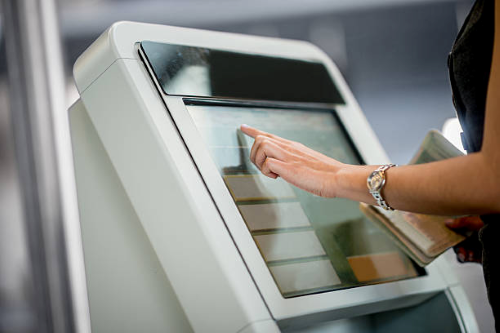Education Kiosks Can Reimagine the Learning Experience
When it comes to technology, the average classroom is a walled garden. While dramatic technology is transforming the world, solutions like education kiosk are still uncommon in the classroom. In some instances, school administrators even oppose these technologies for classroom use.
Most recently, this hardline stance can be witnessed in generative artificial intelligence (AI). Fearing that students will plagiarize content from generative AI as their own, school districts are banning the technology and deploying tools to detect its use. Unfortunately, this approach focuses on a single edge case of cheating rather than the many legitimate and productive benefits the technology can have for both students and teachers.
Because of this hardline stance against technology like generative AI and education kiosks, schools suffer from numerous issues.
1Why do we need to transform the traditional teaching methods?
Lack of engagement
According to the National Center on Safe Supportive Learning Environments, students learn best when engaged. Unfortunately, teachers now struggle to engage their students with the textbooks, handouts, and lectures that have been staples of the classroom for several generations. These tools cannot compete with the devices that younger students have grown accustomed to, such as smartphones, tablets, and other laptops.
Because students are used to interacting with apps and software on a dynamic digital screen, the analogue world of the classroom will never be the same. They will find classroom activities uninteresting, which is not an ideal condition in which to learn. Classrooms need to undergo digital transformation to capture students' hearts - and, more importantly, minds.

Frequent misinformation
Because textbooks are so expensive to publish, distribute, and acquire, they are updated at most once a year. Some classrooms even use textbooks that are several years old. These textbooks may have "facts" that were once considered accurate but are now inaccurate. For example, older physical science books may still list Pluto as a planet, even though it was reclassified as a dwarf planet in 2006.
This Pluto example is minor, but the accumulation of similar outdated information will harm students. They are effectively learning from an often inaccurate base of knowledge. In an era where resources like Wikipedia can be updated in seconds with a quick edit, wrong information should never take so long to correct.
One-size-fits-all approach
Teachers are overwhelmed with large class ratios. In primary schools, for instance, one teacher may handle an average of twenty-three students. In this environment, a teacher may try to personalize some of their instruction - she may push Jan harder than Joe - but fail to do this at scale in any meaningful way.
Teachers must take a one-size-fits-all approach to education. They teach toward the class average, which harms students ahead of and behind that benchmark. Academically successful students will find the pace too slow, while students who may need more help will find it too fast. This lack of personalization is in sharp contrast to other areas of learning, such as professional development, that already have deeply individualized approaches thanks to technology.
2Why choose education kiosks for students?
1Education kiosks can accelerate digital transformation
Schools can mitigate these problems by embracing digital transformation. While no silver bullet will address these issues overnight, some solutions will create more impact than others. School administrators should prioritize these solutions: They will produce the results needed to generate more buy-in to invest in additional software and hardware.
One example is education information kiosk, which can dynamically present announcements, enliven educational material, and streamline school operations. Schools that want to experience these benefits should first procure the hardware and then decide on an MDM like AirDroid Business to help manage the contents displayed in the kiosk. Such as interface, layout, apps, information and block other usages.
In an academic environment, an MDM is necessary for not only moderating content but ensuring that the education kiosks succeed in improving the student experience.

2Education kiosks can reimagine the learning experience
In a technology-free classroom, students would learn about the solar system by reading about the planets, stars, and other celestial objects from a textbook. In contrast, students in a classroom equipped with education kiosks would have a different experience.
On the touch-screen interface, students could select different objects in the universe to zoom in, such as an asteroid. A narrator would then read aloud information about the asteroid, after which students can choose another object to fly to and examine. In this way, the universe would come alive.
This kind of engagement is not limited to astronomy. Many subjects would lend themselves well to dynamic multimedia, presentations, and games on an education kiosk. Teachers can use third-party resources to deliver ready-made experiences for standard modules and topics.
Unfortunately, kiosk for education can be a double-edged sword. Students can freely browse the internet or even third-party apps on devices without an MDM, so while they are engaged - it may be with social media or other sites. Such usage is not only a distraction but one that represents a severe security risk for school networks.
School administrators can prevent such browsing through an MDM. On AirDroid Business, for example, they can activate Single App Kiosk Mode, which will only allow students to use the relevant app. School administrators can set a whitelist or blocklist to greenlight or prohibit different websites based on their URLs. With these controls, school administrators can ensure that students concentrate wholeheartedly on the dynamic content presented on the education kiosk.
3Why choose education kiosks for school administrators?
1Education kiosks can work in real-time
When coupled with an MDM, the content on education kiosks can be updated in real-time, which benefits both students and the wider community. For example, take the case of a senior literature class with a module on current events, comparing what happened in a particular book to what is going on in the news.
If there were significant updates to the news story, the department leadership could push them out to all the education kiosks serving senior literature students. This ease is made possible on AirDroid Business because apps and content can be deployed remotely from the cloud, all from a single back-end. Then the school administrators can view the affected education kiosks to double-check the update through real-time visibility.
Deploying live updates to education kiosks has benefits in and out of the classroom. Schools can send out important reminders to students and parents on education kiosks that specialize in displaying information. This way, the school community will have the latest announcements, enabling stakeholders to operate more efficiently.

Since reminders will be regularly displayed on education kiosks, students and parents will miss fewer deadlines. There will be greater attendance at school events. More students will participate in clubs and other activities. In short, when an MDM powers education kiosks, they can serve as a real-time information clearinghouse for schools.
Education kiosks without an MDM will try to fulfill this purpose, but they will fail. They will inevitably crash, glitch, hang, and face other technical issues as hardware. When this occurs, school administrators will have to call for technical support to view the errant device to fix the problem. Because this process takes time, the device will be offline for an extended period, undermining its purpose of reliably delivering school news.
When an MDM backs educational kiosks, they can be monitored in real-time and fixed this way. On AirDroid, this task is accomplished through remote access, which gives administrators full control of an education device. With this ability, they can get devices running up much faster so that it maintains its status as an information hub for students, parents, and teachers.
2Education kiosks can personalize education
In addition to classrooms and public spaces, education kiosks can be deployed to other academic units, such as libraries and learning centers. There, students can use education kiosks on a one-to-one basis for greater personalized support.
For example, a student may take a sample test of a standardized exam on an education kiosk in a learning center. Based on his results, the module on the education kiosk will give individual feedback: It will advise the student on his weaknesses and how to improve. The recommendations may be as granular as the specific concepts and question types the student needs to work on.
This personalized feedback makes it far easier for students to improve in a particular subject, exam, or extracurricular activity. Schools that use education kiosks for this individualized attention will benefit: They will report higher grades, stronger test scores, and more successful students.
Students will also appreciate this level of personalization and associate it with their school, given that institutions can brand their education kiosks with their visual identity. With an MDM, schools can easily customize their education kiosk's interface with their logo, colors, and other branded materials. This way, students will always recognize that their school drives the highly personalized educational experience. This goodwill will manifest in students and alumni donations, volunteering, and other ways of giving back.
Schools that wish to inspire this kind of loyalty should turn to education kiosks to help create personalization at scale.
4Innovation with education kiosks
Schools that are forward-thinking enough to plan a digital transformation are overwhelmed with possibilities. There are thousands of different software and hardware categories to procure for their classrooms and campuses. Since each will offer unique benefits, school administrators must prioritize the solutions that bring the most value.
From this perspective, education kiosks stand out. While school administrators will have to obtain both the devices and the MDM, the benefits are enormous. With the education kiosks, teachers can present the curriculum more dynamically, schools can display important announcements, and students can input answers and receive personalized feedback.
An MDM further enhances these use cases. With AirDroid Business, schools can present unauthorized browsing through Single-App Kiosk Mode. School administrators can send out content updates or restore errant devices in real-time with full device visibility and remote access. Finally, because these education kiosks can be branded with the school's visual identity, students will associate personalization and other positive benefits with their institution. In short, every school should incorporate education kiosks backed by an MDM into their roadmap for digital transformation.




Leave a Reply.